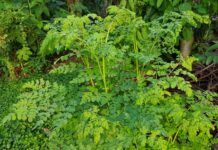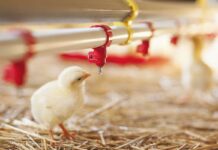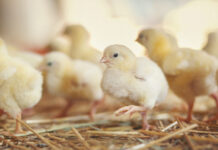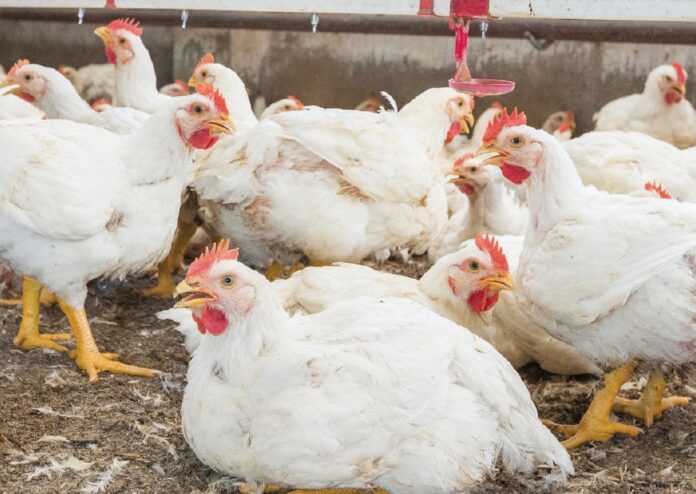
The present study was designed to investigate the effects of a precision glycan Microbiome Metabolic Modulator (MMM) on growth performance and gut health parameters in broiler chickens. The MMM nutritional product was compared against conventional essential oil products and an antibiotic positive control.
S. Ramirez1, V. Jacquier2, M.C Walsh3 and J.M. Geremia4
1 DSM Nutritional Products, Singapore – 2 DSM Nutritional Products, ANH, CRNA, Village-Neuf, France – 3 DSM Nutritional Products, ANH, Kaiseraugst, Switzerland – 4 Midori USA Inc., Cambridge MA, USA
During the study, a natural coccidiosis outbreak appeared, obliging us to conclude the study at 28 days for welfare purposes, but providing us an opportunity to evaluate treatment effects on the emergent coccidiosis. Day-old Ross 308 broiler chicks were randomly allocated to one of six treatments with 8 replicate pens per treatment and 15 birds per pen. Dietary treatments included: 1) negative control (NC); 2) NC with Avilamycin (10 ppm); 3) NC with essential oil product #1 (commercial dose, 40 ppm); 4) NC + essential oil product #2 (commercial dose, 150 ppm); 5) NC + essential oil product #3 (commercial dose, 300 ppm); and 6) NC with MMM (400 ppm in final feed). Body weight (BW), feed intake (FI), and mortality rate were recorded throughout the trial. Feed conversion ratio was corrected for mortality and adjusted to a common body weight (cFCR). Intestinal lesions were scored at the end of the study. Histology samples were also fixed for intestinal morphological determination. In this study, the MMM treatment improved cFCR versus the NC (P<0.05). At the level of the entire intestine, the MMM treatment resulted in reduced intestinal lesions compared to the essential oil treatments and similar to the antibiotic treatment (P<0.05). At the same time, in the duodenum, both the MMM and essential oil treatments reduced the severity of intestinal lesions compared to the NC. Both the MMM and Avilamycin treatments resulted in greater mucosa thickness in the ileum (P=0.02) and villus length (P=0.04) compared to the essential oil treatments. In conclusion, the supplementation of diets with MMM resulted in similar and in some cases superior performance to the Avilamycin treatment and in all cases superior performance to the essential oils treatments. Harnessing the functionality of the microbiome through modulation of microbial metabolite output is a promising new approach to supporting the nutritional health, performance and sustainability of broiler production.
Introduction
Coccidiosis is caused by Apicomplexa protozoa of the family Eimeriidae. In poultry, most species responsible for coccidiosis belong to the genus Eimeria, which infect various sites in the intestine. Coccidiosis is recognized as one of the most common and economically important diseases in broilers, with an estimated $16.7 billion in losses globally per year. The average cost of coccidiosis per chicken produced is estimated to be $0.21. Traditionally, coccidiosis has been controlled through the use of chemical coccidiostats, ionophores, and vaccines. But there is an ongoing effort to decrease the use of chemical and ionophore anti-coccidials due to consumer and regulatory pressure to reduce the overall use of medicated feed additives in broiler production. The industry therefore seeks alternative approaches to managing coccidiosis. This study evaluated the effect of a novel precision glycan microbiome metabolic modulator (MMM) on birds’ resilience that encountered a natural (unintended) coccidiosis outbreak during the grow-out, compared to various common essential oil products.
Method
 Seven hundred and twenty 1-day-old male broiler chicks (Ross 308) were randomly assigned to one of six dietary treatments with eight replicates of 15 chicks per treatment. The birds were fed either a basal diet without any additives as a negative control (NC), the NC diet supplemented with Avilamycin (10 ppm, Surmax 200) serving as a positive control (PC) or the NC diet supplemented with either 40 ppm essential oil product 1, or 150 ppm essential oil product 2, 300 ppm essential oil product 3 and 400 ppm MMM product. Diets were formulated to meet Ross 308 nutritional recommendations (Table 1) and fed over 3 phases including starter (1-10 d), grower (11-24 d) and finisher (25-28 d). The additives were added and mixed homogenously to the basal diets. All diets contained Ronozyme ProAct (200 ppm), Ronozyme HiPhos (2000FYT with only Ca (0.20%) and P (0.18%) and Na (0.02%) matrices applied) and Ronozyme Multigrain (100 ppm), and were steam pelleted and starter diets were further crumbled. Feed and water were provided ad libitum. Birds were reared on reused litter materials from farms previously known to have had coccidiosis challenge. The used litter was topped up with fresh wood shavings to a depth of 3 cm prior to arrival. Chicks were individually weighed on arrival (37±0.5 g) and subsequently pen body weight and feed consumption were determined weekly for 4 weeks. Feed conversion ratio was corrected for mortality and adjusted to the study average body weight. Birds were individually weighed on days 7, 14, 21 and 28 to calculated coefficient of variation for body weight (CV%). Growth performance and histology data were subjected to a generalized linear mixed-effects models, with blocking as random effect, implemented in R. Lesions scores, noted from zero to four (zero for a normal appearance of the intestine and four being severe intestinal damage) were analyzed with a non-parametric Kruskal-Wallis test, using the kruskalmc function from the pgirmess package of R.
Seven hundred and twenty 1-day-old male broiler chicks (Ross 308) were randomly assigned to one of six dietary treatments with eight replicates of 15 chicks per treatment. The birds were fed either a basal diet without any additives as a negative control (NC), the NC diet supplemented with Avilamycin (10 ppm, Surmax 200) serving as a positive control (PC) or the NC diet supplemented with either 40 ppm essential oil product 1, or 150 ppm essential oil product 2, 300 ppm essential oil product 3 and 400 ppm MMM product. Diets were formulated to meet Ross 308 nutritional recommendations (Table 1) and fed over 3 phases including starter (1-10 d), grower (11-24 d) and finisher (25-28 d). The additives were added and mixed homogenously to the basal diets. All diets contained Ronozyme ProAct (200 ppm), Ronozyme HiPhos (2000FYT with only Ca (0.20%) and P (0.18%) and Na (0.02%) matrices applied) and Ronozyme Multigrain (100 ppm), and were steam pelleted and starter diets were further crumbled. Feed and water were provided ad libitum. Birds were reared on reused litter materials from farms previously known to have had coccidiosis challenge. The used litter was topped up with fresh wood shavings to a depth of 3 cm prior to arrival. Chicks were individually weighed on arrival (37±0.5 g) and subsequently pen body weight and feed consumption were determined weekly for 4 weeks. Feed conversion ratio was corrected for mortality and adjusted to the study average body weight. Birds were individually weighed on days 7, 14, 21 and 28 to calculated coefficient of variation for body weight (CV%). Growth performance and histology data were subjected to a generalized linear mixed-effects models, with blocking as random effect, implemented in R. Lesions scores, noted from zero to four (zero for a normal appearance of the intestine and four being severe intestinal damage) were analyzed with a non-parametric Kruskal-Wallis test, using the kruskalmc function from the pgirmess package of R.
Results
The study was halted at 28 d due to a natural coccidiosis outbreak. Oocysts counts were performed and indicated that oocyst counts were above 4000 opg for all treatment groups. The growth performance results are summarized in Table 2.  As there were no significant differences between the three essential oil products, the data were combined into a single treatment, presented as: NC + Essential oils. Under the conditions of the study, the feed intake and the final body weight at 28 d were not different between dietary treatments. Despite the high variability observed in cFCR, MMM significantly improved the cFCR compared to the negative control. There were no differences in mortality rate among treatments.
As there were no significant differences between the three essential oil products, the data were combined into a single treatment, presented as: NC + Essential oils. Under the conditions of the study, the feed intake and the final body weight at 28 d were not different between dietary treatments. Despite the high variability observed in cFCR, MMM significantly improved the cFCR compared to the negative control. There were no differences in mortality rate among treatments.
Intestinal lesions scores on day 28 are reported in Table 3. 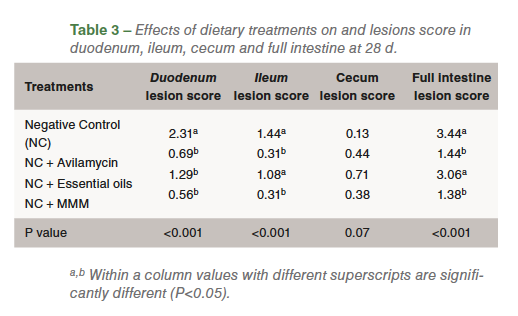 Severity of lesions was greater in the duodenum than that in the ileum, suggesting that E. acervulina and E. maxima were the cause of this coccidiosis outbreak. Both MMM and Avilamycin reduced the degree of damage due to coccidia throughout the intestine, while the essential oil treatment group provided only a limited reduction. Specifically, in the duodenum, all treatments improved lesion scores compared to the NC treatment. However, in the ileum only the Avilamycin and MMM treatment reduced the lesion score compared to the NC treatment.
Severity of lesions was greater in the duodenum than that in the ileum, suggesting that E. acervulina and E. maxima were the cause of this coccidiosis outbreak. Both MMM and Avilamycin reduced the degree of damage due to coccidia throughout the intestine, while the essential oil treatment group provided only a limited reduction. Specifically, in the duodenum, all treatments improved lesion scores compared to the NC treatment. However, in the ileum only the Avilamycin and MMM treatment reduced the lesion score compared to the NC treatment.
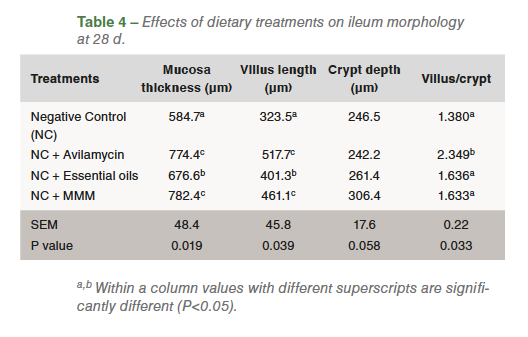
Intestinal morphological parameters are reported in Table 4.MMM significantly increased villus height and mucosa thickness compared to essentials oils and NC treatments, but was not different to the Avilamycin treatment. Villus height:crypt depth ratio was significantly higher in the Avilamycin treatment compared to all other treatments (P=0.03).
Discussion
In this study, MMM was more effective than essential oils at reducing intestinal damage and maintaining growth performance due to a coccidiosis outbreak. MMM resulted in similar increases in ileal mucosa thickness and villus length compared to the Avilamycin treatment. Interestingly, Blokker et al. reported similar effects of MMM on gut morphology following a nutritional and vaccine overdose challenge. Authors suggested that MMM may contribute to reducing dysbacteriosis and promoting resilience to coccidiosis infection. This is consistent with the findings of this present study where intestinal lesions were reduced with MMM, reducing the severity of coccidia infection and loss in feed efficiency similar to the antibiotic treatment. In conclusion, modifying the functional pathways of the microbiome through the use of a precision glycan microbiome metabolic modulator was an effective tool at creating resilience to an enteric insult as seen through reduced performance losses and intestinal damage.
References are available on request
From the Proceedings of the Australian Poultry Science Symposium 2021


